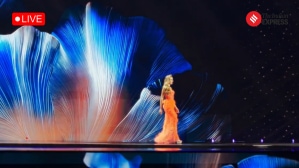Explained: What is retinoblastoma, the common eye cancer in children?
What is retinoblastoma? What are its symptoms and how is it detected? How is it managed?
 Nearly 1,500-2,000 children are diagnosed with retinoblastoma every year in India.
Nearly 1,500-2,000 children are diagnosed with retinoblastoma every year in India.Retinoblastoma is the most common eye cancer occurring in young children and the Department of Ophthalmology, at the Advanced Eye Centre, since 1996, has been running a Retinoblastoma Clinic here three days a week.
The department is the primary referral centre for entire North India and the first point of contact for a majority of patients and caters to Chandigarh, states of Punjab, Haryana, Himachal, Uttarakhand, parts of UP, Rajasthan and J&K. The department offers all state-of-the-art treatment to all patients, which includes laser photocoagulation, cryotherapy, intravitreal chemotherapy, transpupillary thermotherapy, and intravenous and intra-arterial chemotherapy.
As part of the World Retinoblastoma Awareness Week (May 15 to 21), the Retinoblastoma Clinic is conducting awareness lectures with the public, paramedical staff, and doctors to spread awareness about the disease condition. Prof Usha Singh, Department of Ophthalmology heads the Retinoblastoma Clinic and works in close collaboration with senior residents, paediatric and radiation oncologists, interventional neuro-radiologist, and a social worker. The team answers some questions about retinoblastoma.
What is retinoblastoma?
It is the most common cancer in the eye (malignant tumor) in small children. It can occur in one or both eyes and may be hereditary or sporadic. It can be life-threatening as well as take away vision if not treated timely and is detected by seeing White Reflex (WR).
Symptoms
White Reflex in the eye: Pupil that looks white or yellow instead of red when light hits it.
Squinting: A crossed eye, looking either toward the nose or towards the ear.
Poor vision with or without WR. The eye may be red or painful also.
Retinoblastoma disease burden
Nearly 1,500-2,000 children are diagnosed with retinoblastoma every year in India. The majority of these children belong to lower socio-economic strata of society and nearly 60 per cent of these patients have advanced disease at presentation. It is associated with low treatment and survival rates which are due to lack of awareness, social stigma, poor access to care, high cost of treatment, lack of infrastructure, health professionals, good treatment protocols, quality drugs, diagnostics, and supportive care. PGI provides state-of-the-art treatment and has been working tirelessly to mitigate the suffering and financial woes of these children. Financial help is forthcoming from various poor patient funds, government schemes, state cancer funds of Punjab and Haryana, and NGOs. Cankids is a registered NGO under the Indian Cancer Society and under the MoU between PGI and Cankids. The aim is to provide all children with the best treatment to fight this disease, irrespective of their financial status.
How is retinoblastoma detected?
Ocular ultra-sonography and fundus examination are the immediate OPD procedures. Its extent is determined by Magnetic Resonance Imaging (MRI) and systemic staging investigations (bone marrow biopsy, CSF, and whole-body PET scan).
How is retinoblastoma managed?
Retinoblastoma treatment requires a multi-disciplinary approach and this is managed by a team of experts, specialised in taking care of such children.
Treatment planning is done after a complete clinical examination and classification of the disease (grouping and staging). Treatment is individualised to each patient.
Chemotherapy can be delivered intravenously or intra-arterial and is given by the paediatric oncologist and is the most common modality of treatment. This has to be followed up with local therapy, which is managed by the ophthalmologist using various modalities.
Newsletter | Click to get the day’s best explainers in your inbox
Assessing the response and monitoring of the local tumor, the need for change in treatment modality is done on a weekly to monthly basis till the tumor is in control.
After completion of treatment, further monitoring and follow-up are done to keep a watch on the recurrence of disease and side effects of systemic treatment. These patients need lifelong follow-up and genetic counselling offered to parents.



- 01
- 02
- 03
- 04
- 05




































